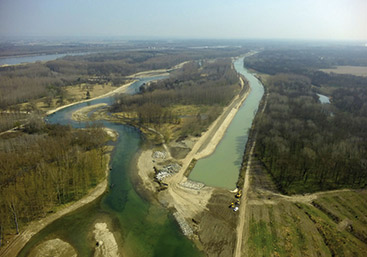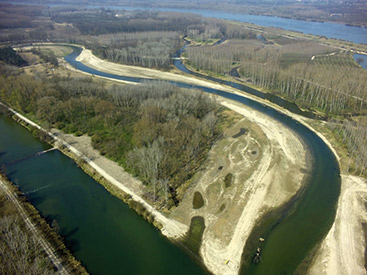Bringing biodiversity back to the floodplains

Bringing biodiversity back to the floodplains
Austria’s largest hydropower plant operator VERBUND is working to reconnect the Traisen River to Austria’s largest enclosed wetlands.

The goal of the project is to reconnect the Traisen to the nearby water bodies and the surrounding wetlands of the Tullnerfelder floodplains, thereby creating a link to Austria’s largest enclosed wetlands.
© Pock/VERBUND
The broad-bodied chaser dragonfly is not a particularly extraordinary dragonfly; it is a fairly common dragonfly usually found near new, shallow waters. However its appearance along the lower reaches of the Traisen River is a good sign, showing that nature is beginning to take hold of the brand new riverbed in the area.
The Traisen River, one of the largest Danube tributaries in Lower Austria, runs for 7.5km through the Tullnerfelder Donau- Auen, a Natura 2000 site which is the largest alluvial forest in Austria. However, the river was heavily modified following the construction of the Altenwörth hydropower plant in 1976. It currently runs in a regulated bed which doesn’t give the river any possibility to expand and which becomes further entrenched year in and year out. The river has been cut off from the surrounding riparian forest, offering few habitats for typical wetland flora and fauna found in floodplains, and fish migration has been almost completely obstructed by obstacles.
In 2008, a plan was approved to create a new Traisen River, one that would be closely linked with the wetlands, offer diverse habitats, and restore fish accessibility. The project is coordinated and mainly financed by VERBUND Hydro Power GmbH (VHP), with co-financing from the LIFE+ programme. Further project partners are the Lower Austrian Fishery Association, the Lower Austrian Landscape Funds, viadonau, as well as the Federal Water Engineering Administration. VHP is Austria’s leading electricity provider and operator of ten Danube hydro power plants.
A complex landscape project. The project will establish a meandering river, which can further develop dynamically in the future and provide new habitats in bodies of flowing water. The project will create a new dynamic riverbed and restore largescale flooding zones to increase the habitat for white willow woods from 6% to 100%. “The goal of the LIFE+ Traisen project is the recovery of a diverse wetlands area, which can be left to its own resources and the natural cycle,” outlined Karl Heinz Gruber, board member of VERBUND Hydro Power GmbH. “The project complements our longstanding, successful practice of constructing and operating our power plants in harmony with nature.”
Construction of fish passes in the floodplain area and on various existing water bodies will make permanent fish migration possible on the new Traisen River, benefitting at least 40 fish species. The gravel dredged up for the new course of the river will be used partly to construct new spawning grounds for fish in the Danube and a large part of the gravel will also be placed back downstream from the Danube, to prevent erosion. In October 2014 the first stage of construction, a roughly 2km-long curved section of the new Traisen, was completed and handed back over to nature.
The main work will be completed by 2016, and the ecological diversity will benefit not only nature, but also the neighbouring municipalities, fishermen and tourists. “Lower Austria is well-known for its nature and it can be proud of this Europe-wide model project,” says Stephan Pernkopf, member of the provincial government. “Nature and people equally profit here from a diverse floodplain landscape, which gives the river more space and which can keep back water masses when flooding occurs.”
For more information on the project, visit:
www.life-traisen.at.

The lower reaches of the Traisen River between Traismauer and Zwentendorf will be revitalised with a lively floodplains landscape. Specialists will enhance the course of the river and landscape with meanders, shallow water zones and pools following plans by ecology experts.
© Pock/VERBUND
Network Danube
The Life+ project Network Danube, initiated by VHP in 2011 and running through 2017, aims to restore accessibility for fish at selected sections of the Danube. Improvements for fish include the creation of new habitats through the construction of bypass channels with manifold structures, which will benefit 17 fish species protected by the Flora-Fauna-Habitats Directive, and connect four Natura-2000 areas through the creation of ‘ecological stepping stones’. This project will be the largest of its kind in Austria, with a total investment of around 25 million Euros and six financing partners (the EU, Austrian Federal Ministry of Agriculture, Forestry, Environment and Water Management, state governments of Upper and Lower Austria, and Upper and Lower Austrian Fishery Associations), and the impact of the measures will extend far beyond the boundaries of the actual projects themselves.
Ottensheim-Wilhering bypass channel
In early 2015, VHP began construction of Europe’s longest fish ladder to date at the Ottensheim-Wilhering power plant. Via a 14.2km diversion route through the Innbach-Aschach river, the natural discharge dynamics of the tributaries are simulated by means of season-dependent water volumes and
new habitats are thus created. This bypass channel best meets the high ecological and technical requirements for passability for fish. Furthermore, through the near-natural design of the construction with deep pools, fords and inlets, the project will create additional habitats for fish and other animals.
Once completed in autumn 2016, the fish ladder will bypass the Ottensheim-Wilhering power plant, with the diversion channel in the southern Eferding Basin. It will integrate sections of the Brandstätter tributary, the Aschach diversion stream and the Innbach River. The channel will therefore run parallel to the old Brandstätter tributary and flow into the residual water section of the Aschach near the village of Brandstatt. Together with the module ‘Abwinden-Asten power plant secondary channel at the beginning of the backwater area’, the project will create a habitat compound on the Danube in Austriathat has a unique size and quality.
Abwinden-Asten power plant head of reservoir backwater
Approximately 500m of the head of reservoir area at Abwinden-Asten power plant will be restructured. The rip-rap at the banks will be removed to create new habitats for fish and other aquatic fauna. Some 200,000m3 of gravel will be moved, mostly for measures in the head-of-reservoir area as well as for reshaping the estuary areas on the left bank’s sediment distributor stream and the Große Rodl on the opposite bank.
Abwinden-Asten power plant bypass channel
The Abwinden–Asten power plant will be equipped with a vertical slot to bridge a total difference in height of 9.3 m at low tide between reservoir area and tailrace. Using the best available international technology, the access will lie downstream from the turbine outlets, ensuring that the fish ladder can be easily located, especially for the spawning migration of species that love the current (nase, barb and Danube salmon). The exit will lie downstream of the Traun estuary, enabling fish swimming upstream to travel further in the Danube or to migrate into the Traun.
Melk power plant head of reservoir gravel banks
New gravel banks at the so-called ‘Ybbser Scheibe’ in the Melk power plant head of reservoir will expand on the successful Danube-Ybbs LIFE+ networking project. The shoreline will be structured between river kilometres 2057.70 and 2054.90, to create a sequence of gravel banks and gravel islands through which calm flow zones will emerge, along with shallow gravel surfaces that are flooded at low and mean-flow conditions. This will improve water ecology conditions, especially in relation to the reproduction conditions for fish species requiring gravelly, flooded shallow water zones.
Greifenstein power plant - continuous accessibility
The Greifenstein power plant is getting a near-natural bypass stream to serve as a fish migration channel to overcome a height difference of 12 metres. The bypass stream is almost 4km long and runs independently from the famous Gießgang in the Greifenstein floodplain. The design of the entry is particularly challenging, as it must have a sufficiently attractive current at different water levels in order to point the way for the fish. After the completion of the construction works, the effectiveness of the fish migration channels will be evaluated in 2020.
For more information, please visit:
www.life-netzwerk-donau.at





